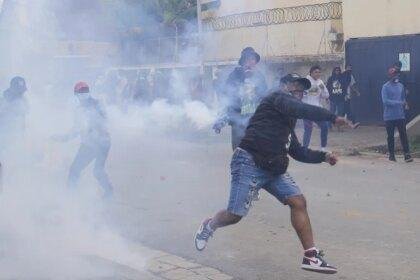The Harrowing Journey of Deported Afghans: A Cycle of Desperation and Return
As the sun beats down on the dusty border of Islam Qala, Afghanistan, a steady stream of weary individuals crosses into their homeland from Iran. Many carry little more than the clothes on their backs, while others clutch suitcases filled with remnants of their lives abroad. The faces of these returnees are etched with exhaustion, confusion, and fear, reflecting the harsh realities of their recent experiences.
A Surge in Deportations
This year alone, Iran has deported approximately 1.3 million Afghans, a staggering figure that underscores the ongoing humanitarian crisis in the region. Many of those returning have fled their homeland in search of better economic opportunities, only to find themselves forcibly sent back, often under violent circumstances. Reports indicate that some individuals have faced brutal arrests, raising serious concerns about human rights violations.
Among the returnees is Rohullah Mohammadi, a young man dressed in a smart blue suit, a stark contrast to the sandy landscape around him. Rohullah had ventured to Iran with hopes of building a better life and supporting his family back home. However, his dreams were shattered when he was apprehended by Iranian authorities. “They took everything I had and sent me back to Afghanistan,” he recounts, visibly shaken. “They even beat me. They injured my ear. Is this how Islam is supposed to be practiced?”
The Human Cost of Economic Migration
Rohullah’s story is not unique. At the peak of the deportations, as many as 28,000 people crossed this border in a single day. While some returnees receive temporary assistance from the United Nations and Taliban authorities, the overwhelming pressure of returning to a life of hardship quickly sets in. Many face the daunting task of rebuilding their lives in a country still grappling with the aftermath of decades of conflict.
Fatimah, a mother of two, shares her own harrowing experience. She had taken her daughters to Iran in search of work, only to find that they were exploited and unpaid. “My two daughters worked from six in the morning until 8:30 at night,” she recalls, tears streaming down her face. “But they were never paid. The Iranians didn’t give them any money.”
The Plight of Unaccompanied Minors
The situation is particularly dire for unaccompanied minors. Many children, like 15-year-old Tahir, have been smuggled into Iran, often incurring significant debt to traffickers. Tahir, who has taken on the role of breadwinner for his family, recently endured 16 days of brutal treatment in a detention center. “They would force us to lie down on the concrete floor and kick us,” he explains, his voice trembling. Despite the trauma, he feels compelled to return to Iran to support his family. “I would rather kill myself than see my father begging for money for his hungry children,” he states, highlighting the immense pressure young individuals face in such dire circumstances.
A Broader Context: Regional Deportations
The deportations from Iran are part of a larger trend affecting Afghanistan. Pakistan has also expelled tens of thousands of Afghans this year, further straining the already fragile situation in the country. Human rights organizations have raised alarms about the treatment of deportees, noting that even those with legal status in Iran have been swept up in the crackdown. The Iranian government has not responded to inquiries regarding these allegations, leaving many questions unanswered.
The Impact of Taliban Policies on Women
Among the returnees are women who fled Afghanistan to escape the Taliban’s oppressive policies, particularly those affecting education and employment. One mother, recently forced to return, expressed her despair over the restrictions imposed on women. “Every day brought a new restriction, a new policy aimed at preventing women from working,” she laments. Her daughter, once passionate about poetry, has been silenced by the regime’s return to power.
Bittersweet Reunions
For many, the return home is bittersweet. Tahir, who has not seen his family for two years, is greeted with tears and joy. His mother, Gulghoty, explains the difficult choices they face. “Life here was very hard for him,” she says. “He needs a stable life and a future.” Despite the emotional reunion, the reality remains that Tahir may have to leave again to provide for his family.
The Cycle of Desperation
The stories of Rohullah, Fatimah, and Tahir illustrate a broader narrative of desperation and resilience among Afghans. Many are caught in a relentless cycle of migration, forced to leave their homes in search of better opportunities, only to face violence and deportation. The situation is exacerbated by the Taliban’s restrictive policies, which have left many feeling hopeless about their future.
As the international community grapples with the complexities of the Afghan crisis, the plight of these returnees serves as a stark reminder of the human cost of political and economic instability. The challenges they face are not merely personal; they reflect a national tragedy that demands urgent attention and action.
Conclusion
The ongoing deportations of Afghans from Iran highlight a humanitarian crisis that is far from resolved. As individuals like Rohullah, Fatimah, and Tahir navigate the treacherous waters of survival, their stories call for a compassionate response from the global community. Addressing the root causes of migration, ensuring the protection of human rights, and providing support for those affected are essential steps toward alleviating the suffering of millions caught in this cycle of despair.











